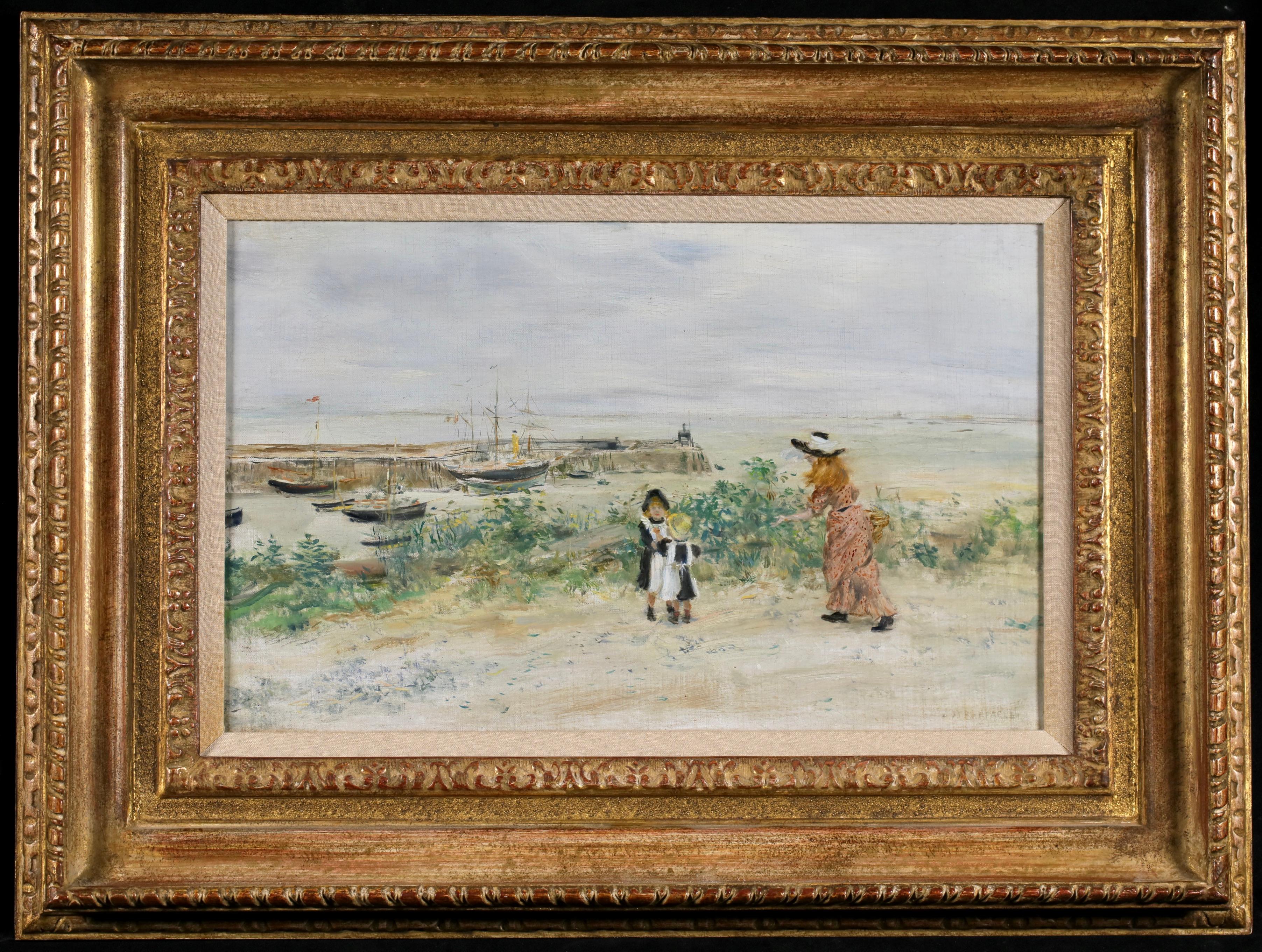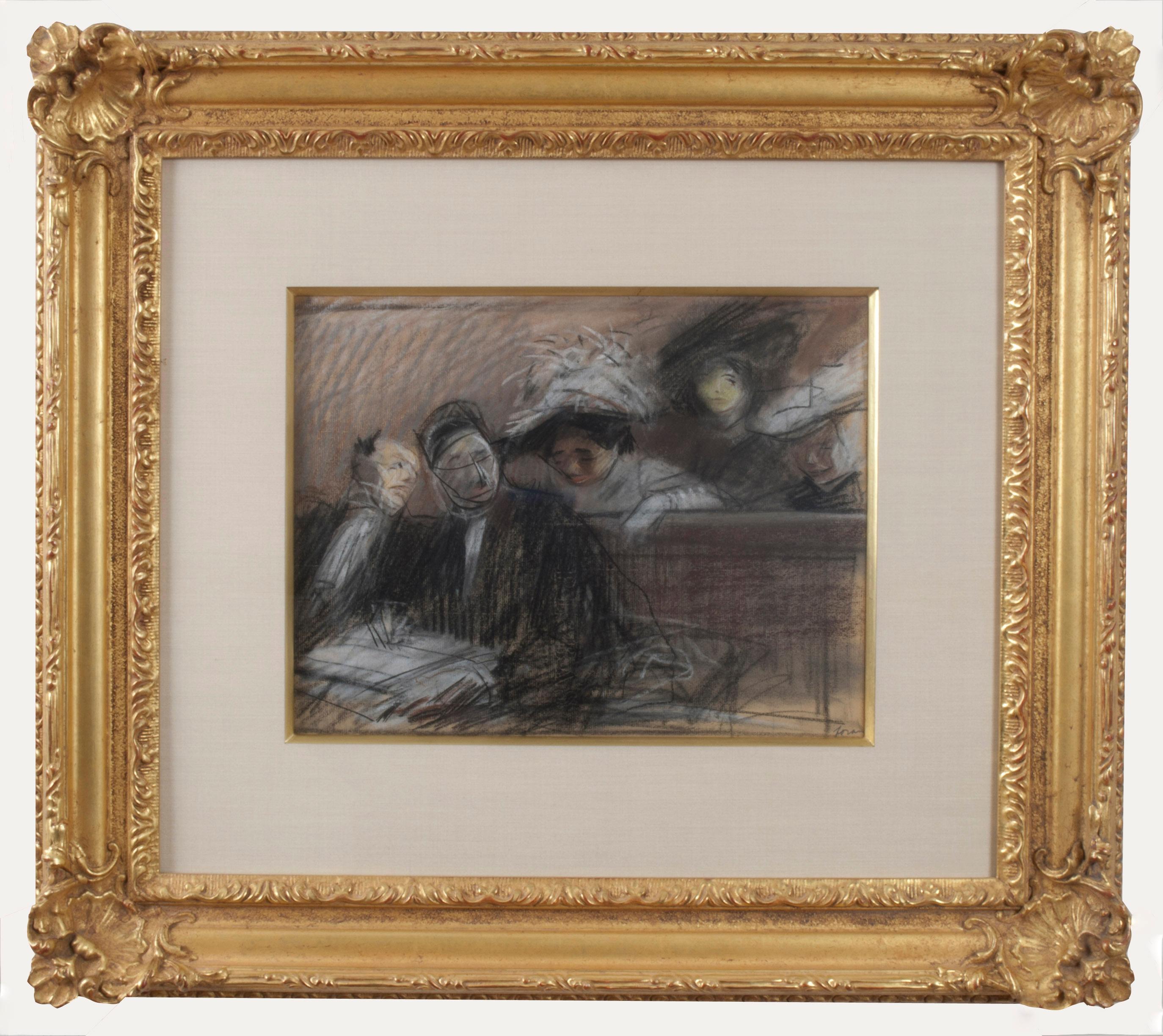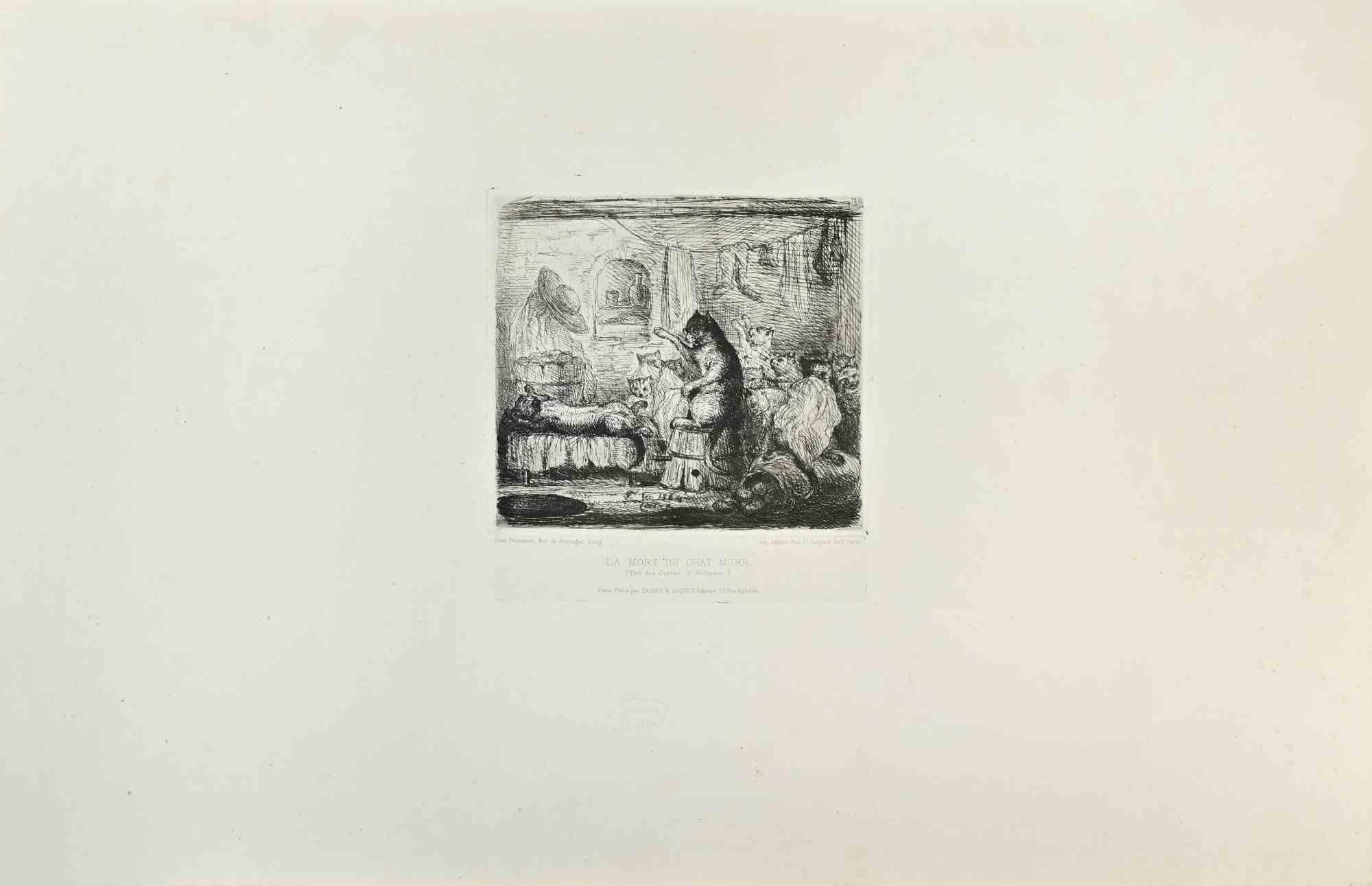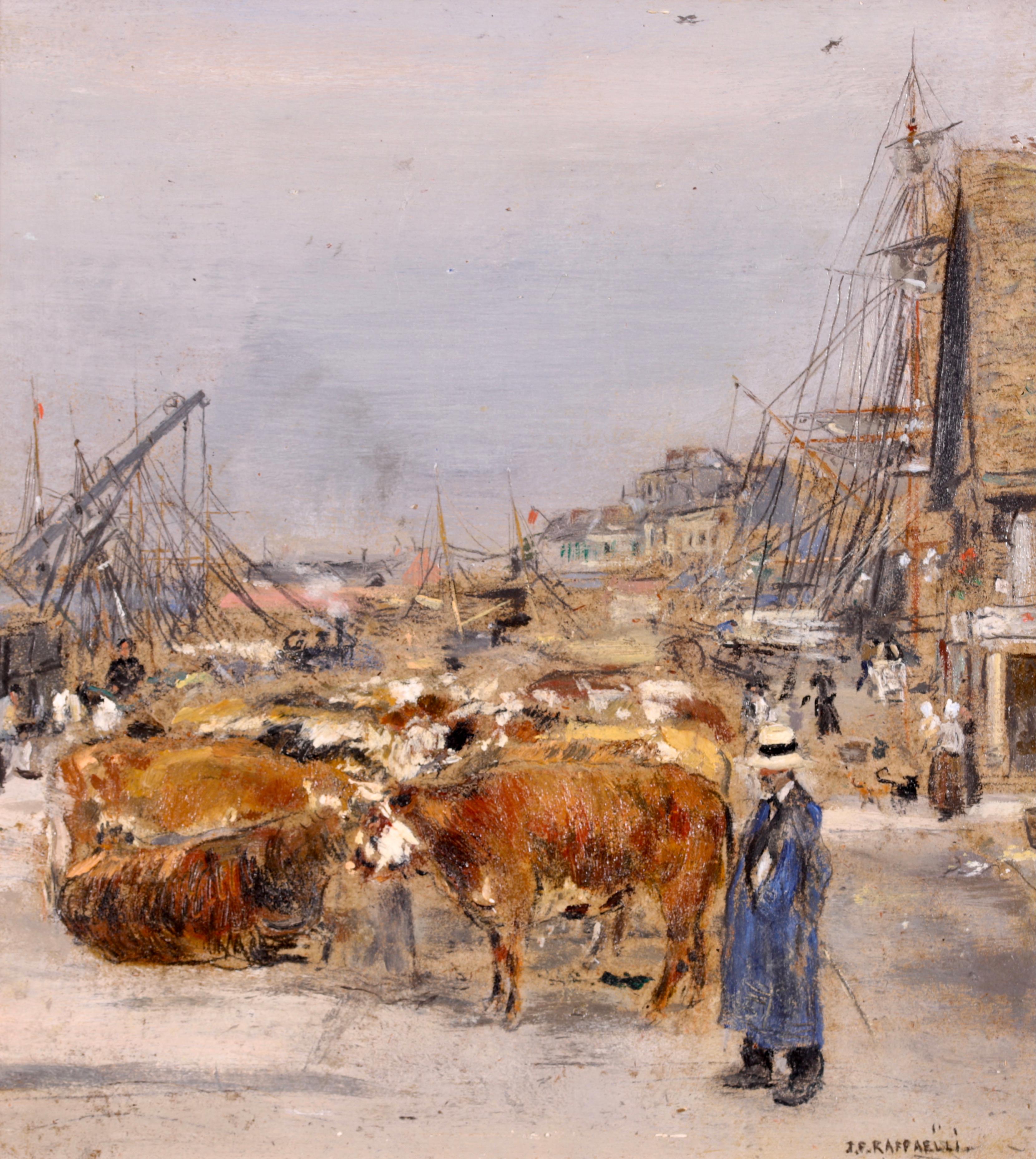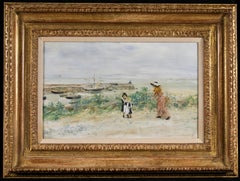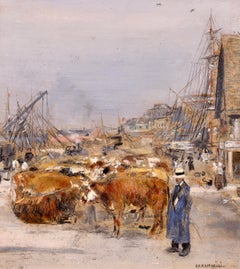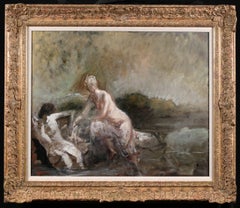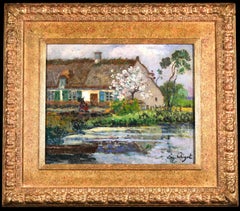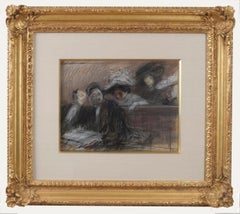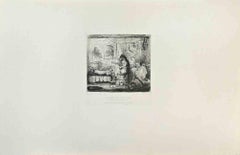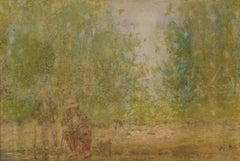Items Similar to Deux vieillards aux chatons - Impressionist Figurative Oil by J F Raffaelli
Want more images or videos?
Request additional images or videos from the seller
1 of 15
Jean-Francois RaffaelliDeux vieillards aux chatons - Impressionist Figurative Oil by J F Raffaellic.1890
c.1890
$15,043.44
£11,055
€12,919.48
CA$20,802.83
A$22,648.97
CHF 12,093.83
MX$273,408.59
NOK 152,041.09
SEK 141,415.90
DKK 96,502.20
About the Item
Signed figures in interior oil on panel by French impressionist painter Jean-Francois Raffaelli. The piece depicts two old men seated in an interior. One is reading his paper as the other naps and there are several kittens on the floor. Painted in the artist's distinctive style.
Signature:
Signed lower left
Dimensions:
Framed: 9.5"x8"
Unframed: 5.5"x4"
Provenance:
Brame & Lorenceau have confirmed the authenticity of this work and it will be included in the digital catalogue raisonne of the painter which is under preparation
A certificate of authenticity fromBrame & Lorenceau accompanies this painting
Private collection - United States
Original artists label verso
Jean-François Raffaëlli's father was a failed Italian businessman and Raffaëlli himself was, among other things, a church chorister, actor and theatre singer. He then studied under Gérôme at the École des Beaux-Arts in Paris. He travelled to Italy, Spain and Algeria and on his return to France settled in Asnières.
In 1876, on a trip to Brittany, he first saw the potential of realist subject matter, if treated seriously. He became involved in meetings of artists at the Café Guerbois, where the Impressionist painters used to gather. As a result, Degas, contrary to the advice of the group, introduced Raffaëlli to the Impressionist exhibitions - according to one uncertain source as early as the very first exhibition, at the home of Nadar, and certainly to those of 1880 and 1881.
In 1904, Raffaëlli founded the Society for Original Colour Engraving. He first exhibited at the Salon de Paris in 1870 and continued to exhibit there until he joined the Salon des Artistes Français in 1881, where he earned a commendation in 1885, was made Chevalier of the Légion d'Honneur in 1889 and in the same year was awarded a gold medal at the Exposition Universelle. In 1906 he was made Officier of the Légion d'Honneur. He was also a member of the Société Nationale des Beaux-Arts. In 1884, a private exhibition of his work cemented his reputation.
He contributed to several newspapers such as The Black Cat (Le Chat Noir) in 1885 and The French Mail (Le Courrier Français) in 1886 and 1887. He published a collection entitled Parisian Characters, which captured his favourite themes of the street, the neighbourhood and local people going about their lives. In 1880 he participated, with Forain, on the illustration of Joris Karl Huysmans' Parisian Sketches (Croquis Parisiens). He also illustrated Huysman's Works. As well as working as an illustrator, he also made etchings and coloured dry-points.
His early attempts at painting were genre scenes, but once he was settled in Asnières he started to paint picturesque views of Parisian suburbs. From 1879 onwards, his subject matter drew on the lives of local people. These popular themes, which he treated with humanity and a social conscience, brought him to the attention of the social realist writers of the time such as Émile Zola. In addition to his realist style, Raffaëlli's dark palette, which ran contrary to the Impressionist aesthethic, helped to explain the opposition of those painters to his participation in their exhibitions. More concerned with drawing than colour, he used black and white for most of his paintings. Towards the end of his life, he lightened his palette, but without adopting any other principles of the Impressionist technique.
After painting several portraits, including Edmond de Goncourt and Georges Clémenceau, he returned to genre painting, particularly scenes of bourgeois life. Later in his career, he painted mainly Breton-inspired sailors and views of Venice. His views of the Paris slums and the fortifications, sites which have almost completely disappeared, went some way towards establishing a genre in themselves and perpetuated the memory of the area: The Slums, Rag-and-Bone Man, Vagabond, Sandpit, In St-Denis, Area of Fortifications. His realistic and witty portrayal of typical Parisian townscapes accounts for his enduring appeal.
Born in Paris, he was of Tuscan descent through his paternal grandparents. He showed an interest in music and theatre before becoming a painter in 1870. One of his landscape paintings was accepted for exhibition at the Salon in that same year. In October 1871 he began three months of study under Jean-Léon Gérôme at the École des Beaux-Arts in Paris; he had no other formal training.
Raffaëlli produced primarily costume pictures until 1876, when he began to depict the people of his time—particularly peasants, workers, and ragpickers seen in the suburbs of Paris—in a realistic style. His new work was championed by influential critics such as J.-K. Huysmans, as well as by Edgar Degas.
The ragpicker became for Raffaëlli a symbol of the alienation of the individual in modern society. Art historian Barbara S. Fields has written of Raffaëlli's interest in the positivist philosophy of Hippolyte-Adolphe Taine, which led him to articulate a theory of realism that he christened caractérisme. He hoped to set himself apart from those unthinking, so-called realist artists whose art provided the viewer with only a literal depiction of nature. His careful observation of man in his milieu paralleled the anti-aesthetic, anti-romantic approach of the literary Naturalists, such as Zola and Huysmans.
Degas invited Raffaëlli to participate in the Impressionist exhibitions of 1880 and 1881, an action that bitterly divided the group; not only was Raffaëlli not an Impressionist, but he threatened to dominate the 1880 exhibition with his outsized display of 37 works. Monet, resentful of Degas's insistence on expanding the Impressionist exhibitions by including several realists, chose not to exhibit, complaining, "The little chapel has become a commonplace school which opens its doors to the first dauber to come along."An example of Raffaëlli's work from this period is Les buveurs d'absinthe (1881, in the California Palace of Legion of Honor Art Museum in San Francisco). Originally titled Les déclassés, the painting was widely praised at the 1881 exhibit.
After winning the Légion d'honneur in 1889, Raffaëlli shifted his attention from the suburbs of Paris to city itself, and the street scenes that resulted were well received by the public and the critics. He made a number of sculptures, but these are known today only through photographs.[2] His work was also part of the painting event in the art competition at the 1912 Summer Olympics. In the later years of his life, he concentrated on color printmaking. Raffaëlli died in Paris on February 11, 1924
Museum and Gallery Holdings:
Béziers: Peasants Going to Town
Bordeaux: Bohemians at a Café
Boston: Notre-Dame; Return from the Market
Brussels: Chevet of Notre-Dame; pastel
Bucharest (Muz. National de Arta al României): Market at Antibes; Pied-à-terre
Copenhagen: Fishermen on the Beach
Douai: Return from the Market; Blacksmiths
Liège: Absinthe Drinker
Lyons (MBA): At the Foundry
Morlaix: Portrait of Gustave Geffroy
Mulhouse: Little Street
Nancy (MBA): Portrait of Edmond de Goncourt
Nantes (MBA): Rag-and-Bone Man Lighting his Pipe
Oslo: Parisian Street in Sunlight
Paris (Mus. d'Orsay): Guests Attending a Wedding; Elderly Convalescents; Notre-Dame; Public Meeting; Judith
Rheims: Drouot Crossroads in Paris
Stockholm: Sailors at a Northern French Port
Versailles: Clémenceau the Orator
- Creator:Jean-Francois Raffaelli (1850-1924, French)
- Creation Year:c.1890
- Dimensions:Height: 9.5 in (24.13 cm)Width: 8 in (20.32 cm)
- Medium:
- Movement & Style:
- Period:
- Condition:Very good original condition.
- Gallery Location:Marlow, GB
- Reference Number:Seller: LFA04031stDibs: LU41538827872
About the Seller
5.0
Gold Seller
Premium sellers maintaining a 4.3+ rating and 24-hour response times
Established in 2001
1stDibs seller since 2016
710 sales on 1stDibs
Typical response time: 3 hours
- ShippingRetrieving quote...Shipping from: Marlow, United Kingdom
- Return Policy
More From This Seller
View AllMother & Children - Impressionist Figurative Oil by Jean-Francois Raffaelli
By Jean-Francois Raffaelli
Located in Marlow, Buckinghamshire
Signed oil on canvas figures in landscape by French impressionist painter Jean-Francois Raffaelli. The work depicts two young girls with their mother in a landscape overlooking boats...
Category
Early 1900s Impressionist Figurative Paintings
Materials
Oil, Canvas
L'embarquement de boeufs - Impressionist Oil, Cattle by Jean Francois Raffaelli
By Jean-Francois Raffaelli
Located in Marlow, Buckinghamshire
Wonderful signed oil on panel cattle and figures in landscape by French impressionist painter Jean-Francois Raffaelli. The work depicts oxen being loaded onto ships in Honfleur, France en route to England.
Signature:
Signed lower right
Dimensions:
Framed: 18"x16"
Unframed: 9"x8"
Provenance:
Exhibition Jean Francois Raffaélli held at Galerie Simonson, 19 Rue Caumartin Paris - October 1929 (number 44)
Jean-François Raffaëlli's father was a failed Italian businessman and Raffaëlli himself was, among other things, a church chorister, actor and theatre singer. He then studied under Gérôme at the École des Beaux-Arts in Paris. He travelled to Italy, Spain and Algeria and on his return to France settled in Asnières.
In 1876, on a trip to Brittany, he first saw the potential of realist subject matter, if treated seriously. He became involved in meetings of artists at the Café Guerbois, where the Impressionist painters used to gather. As a result, Degas, contrary to the advice of the group, introduced Raffaëlli to the Impressionist exhibitions - according to one uncertain source as early as the very first exhibition, at the home of Nadar, and certainly to those of 1880 and 1881.
In 1904, Raffaëlli founded the Society for Original Colour Engraving. He first exhibited at the Salon de Paris in 1870 and continued to exhibit there until he joined the Salon des Artistes Français in 1881, where he earned a commendation in 1885, was made Chevalier of the Légion d'Honneur in 1889 and in the same year was awarded a gold medal at the Exposition Universelle. In 1906 he was made Officier of the Légion d'Honneur. He was also a member of the Société Nationale des Beaux-Arts. In 1884, a private exhibition of his work cemented his reputation.
He contributed to several newspapers such as The Black Cat (Le Chat Noir) in 1885 and The French Mail (Le Courrier Français) in 1886 and 1887. He published a collection entitled Parisian Characters, which captured his favourite themes of the street, the neighbourhood and local people going about their lives. In 1880 he participated, with Forain, on the illustration of Joris Karl Huysmans' Parisian Sketches (Croquis Parisiens). He also illustrated Huysman's Works. As well as working as an illustrator, he also made etchings and coloured dry-points.
His early attempts at painting were genre scenes, but once he was settled in Asnières he started to paint picturesque views of Parisian suburbs. From 1879 onwards, his subject matter drew on the lives of local people. These popular themes, which he treated with humanity and a social conscience, brought him to the attention of the social realist writers of the time such as Émile Zola. In addition to his realist style, Raffaëlli's dark palette, which ran contrary to the Impressionist aesthethic, helped to explain the opposition of those painters to his participation in their exhibitions. More concerned with drawing than colour, he used black and white for most of his paintings. Towards the end of his life, he lightened his palette, but without adopting any other principles of the Impressionist technique.
After painting several portraits, including Edmond de Goncourt and Georges Clémenceau, he returned to genre painting, particularly scenes of bourgeois life. Later in his career, he painted mainly Breton-inspired sailors and views of Venice. His views of the Paris slums and the fortifications, sites which have almost completely disappeared, went some way towards establishing a genre in themselves and perpetuated the memory of the area: The Slums, Rag-and-Bone Man, Vagabond, Sandpit, In St-Denis, Area of Fortifications. His realistic and witty portrayal of typical Parisian townscapes accounts for his enduring appeal.
Born in Paris, he was of Tuscan descent through his paternal grandparents. He showed an interest in music and theatre before becoming a painter in 1870. One of his landscape paintings was accepted for exhibition at the Salon in that same year. In October 1871 he began three months of study under Jean-Léon Gérôme at the École des Beaux-Arts in Paris; he had no other formal training.
Raffaëlli produced primarily costume pictures until 1876, when he began to depict the people of his time—particularly peasants, workers, and ragpickers seen in the suburbs of Paris—in a realistic style. His new work was championed by influential critics such as J.-K. Huysmans, as well as by Edgar Degas.
The ragpicker became for Raffaëlli a symbol of the alienation of the individual in modern society. Art historian Barbara S. Fields has written of Raffaëlli's interest in the positivist philosophy of Hippolyte-Adolphe Taine, which led him to articulate a theory of realism that he christened caractérisme. He hoped to set himself apart from those unthinking, so-called realist artists whose art provided the viewer with only a literal depiction of nature. His careful observation of man in his milieu paralleled the anti-aesthetic, anti-romantic approach of the literary Naturalists, such as Zola and Huysmans.
Degas invited Raffaëlli to participate in the Impressionist exhibitions of 1880 and 1881, an action that bitterly divided the group; not only was Raffaëlli not an Impressionist, but he threatened to dominate the 1880 exhibition with his outsized display of 37 works. Monet, resentful of Degas's insistence on expanding the Impressionist exhibitions by including several realists, chose not to exhibit, complaining, "The little chapel has become a commonplace school which opens its doors to the first dauber to come along."An example of Raffaëlli's work from this period is Les buveurs d'absinthe (1881, in the California Palace of Legion of Honor Art Museum in San Francisco). Originally titled Les déclassés, the painting was widely praised at the 1881 exhibit.
After winning the Légion d'honneur in 1889, Raffaëlli shifted his attention from the suburbs of Paris to city itself, and the street scenes that resulted were well received by the public and the critics. He made a number of sculptures, but these are known today only through photographs.[2] His work was also part of the painting event in the art competition at the 1912 Summer Olympics. In the later years of his life, he concentrated on color printmaking. Raffaëlli died in Paris on February 11, 1924
Museum and Gallery Holdings:
Béziers: Peasants Going to Town
Bordeaux: Bohemians at a Café
Boston: Notre-Dame; Return from the Market
Brussels: Chevet of Notre-Dame; pastel
Bucharest (Muz. National de Arta al României): Market at Antibes; Pied-à-terre
Copenhagen: Fishermen on the Beach
Douai: Return from the Market; Blacksmiths
Liège: Absinthe Drinker...
Category
1880s Impressionist Animal Paintings
Materials
Oil, Panel
Les Baigneuses - Impressionist Figurative Landscape Oil by Jean Louis Forain
By Jean Louis Forain
Located in Marlow, Buckinghamshire
Signed impressionist figurative oil on canvas circa 1890 by sought after French impressionist painter Jean Louis Forain. The piece depicts bathers in a dark landscape.
Signature:
Signed lower right
Dimensions:
Framed: 32"x37"
Unframed: 24"x29"
Provenance:
Private French collection
Jean Forain was the son of a painter and decorator and was apprenticed to a visiting card engraver. He studied briefly under Gérôme and Carpeaux at the École des Beaux-Arts in Paris and regularly visited the Louvre, where he copied works by the masters. It is said that for a time he made a precarious living by selling small drawings in the style of Grévin. He went on to collaborate on various publications as a draughtsman and columnist, starting in 1876 on La Cravache and then collaborating on the newspapers Le Journal Amusant, Le Figaro and L'Écho de Paris. This introduced him to the diverse worlds of Paris society - the world of the theatre, of shows, and of literature - where he wryly noted the habits and shortcomings particular to each. This led him to follow a route very characteristic of this period, already seen in the work of Steinlen, Caran d'Ache and Toulouse-Lautrec in the journals La Pléiade, La Vogue...
Category
1890s Impressionist Figurative Paintings
Materials
Canvas, Oil
Pommier en fleur - Post Impressionist Figures in Landscape Oil by Eugene Chigot
By Eugene Henri Alexandre Chigot
Located in Marlow, Buckinghamshire
Signed post impressionist figures in landscape oil on panel circa 1910 by French painter Eugene Henri Alexandre Chigot. The work depicts a mother and child outside a thatched cottage beside a pond. In the centre of the painting is an apple tree in blossom - beautifully painted in pinks, blues and greens.
Signature:
Signed lower right
Dimensions:
Framed: 19"x22.5"
Unframed: 12.5"x16"
Provenance:
Private French collection
A pupil of his father Alphonse Chigot, Eugène Chigot...
Category
1910s Post-Impressionist Landscape Paintings
Materials
Oil, Panel
Le Pont Neuf - Impressionist Figures in Landscape Oil by Amedee Marcel-Clement
By Amedee Julien Marcel-Clement
Located in Marlow, Buckinghamshire
Signed and dated figures in cityscape oil on panel by French impressionist painter Amedee Marcel-Clement. The work depicts a view of the Pont Neuf bridge that runs over the River Sei...
Category
1910s Impressionist Figurative Paintings
Materials
Oil, Panel
Les Vacances - Post Impressionist Figures in Landscape Oil by Pierre Montezin
By Pierre Eugène Montezin
Located in Marlow, Buckinghamshire
Signed oil on canvas figures in riverscape circa 1910 by sought after French impressionist painter Pierre Eugene Montezin. The work depicts women dressed in summer dresses and sunhat...
Category
1910s Impressionist Figurative Paintings
Materials
Canvas, Oil
You May Also Like
Le Resesquement a l'Advocats (The Legal Reservation)
By Jean Louis Forain
Located in Fairlawn, OH
Le Resesquement a l'Advocats
(The Legal Reservation)
Pastel on paper, c. 1910
signed lower right
Image size: 10 3/4 x 14 inches
Frame size: 23-1/2 x 26-1/2 x 2-3/8 inches
Condition: ...
Category
Early 1900s Impressionist Figurative Paintings
Materials
Pastel
La Mort du Chat Murr - Etching by Jean François Raffaëlli - 1875
By Jean-Francois Raffaelli
Located in Roma, IT
Etching on laid paper
Signed in plate lower left: Jean François Raffaëlli.
Published by Cadart & Luquet, Éditeurs, 79 Rue Richelieu, Paris
With the blindstamp of the Société des Aqua...
Category
1870s Modern Figurative Prints
Materials
Drypoint, Etching
Two Old Men Sitting - Mid 20th Century Impressionist Oil Pastel by William Mason
By William Mason
Located in Watford, Hertfordshire
William Mason (1906-2002) was a painter born in Newport, Wales, who studied at Newport College of Art and the Royal College of Art. Aside from painting he also taught at Scarborough...
Category
1950s Impressionist Landscape Paintings
Materials
Oil Pastel
Chez les Basileus
By Jean Louis Forain
Located in San Francisco, CA
Artist: Jean-Louis Forain (French, 1852-1931)
Title: Chez les Basileus
Year: 1918
Medium: Lithograph
Edition: Numbered 266/300 in pencil
Paper: Wove
Size paper: 15 x 22.25 inch...
Category
Early 20th Century Impressionist Figurative Prints
Materials
Lithograph
La Mort du Chat Murr - Etching by Jean François Raffaëlli - 1875
By Jean-Francois Raffaelli
Located in Roma, IT
Etching on laid paper
Inscribed in pencil: Épreuve tirée de la planche donnée personnellement par l’artiste pour la Société des Aquafortistes
Published by Cadart & Luquet, Éditeu...
Category
1870s Modern Figurative Prints
Materials
Drypoint, Etching
Confidences, oil/panel, 37x50 cm
Located in Riga, LV
Francisco Domingo y Marques(Spanish, 1842-1920)
Category
Early 20th Century Impressionist Figurative Paintings
Materials
Canvas, Oil
$2,470 Sale Price
20% Off
